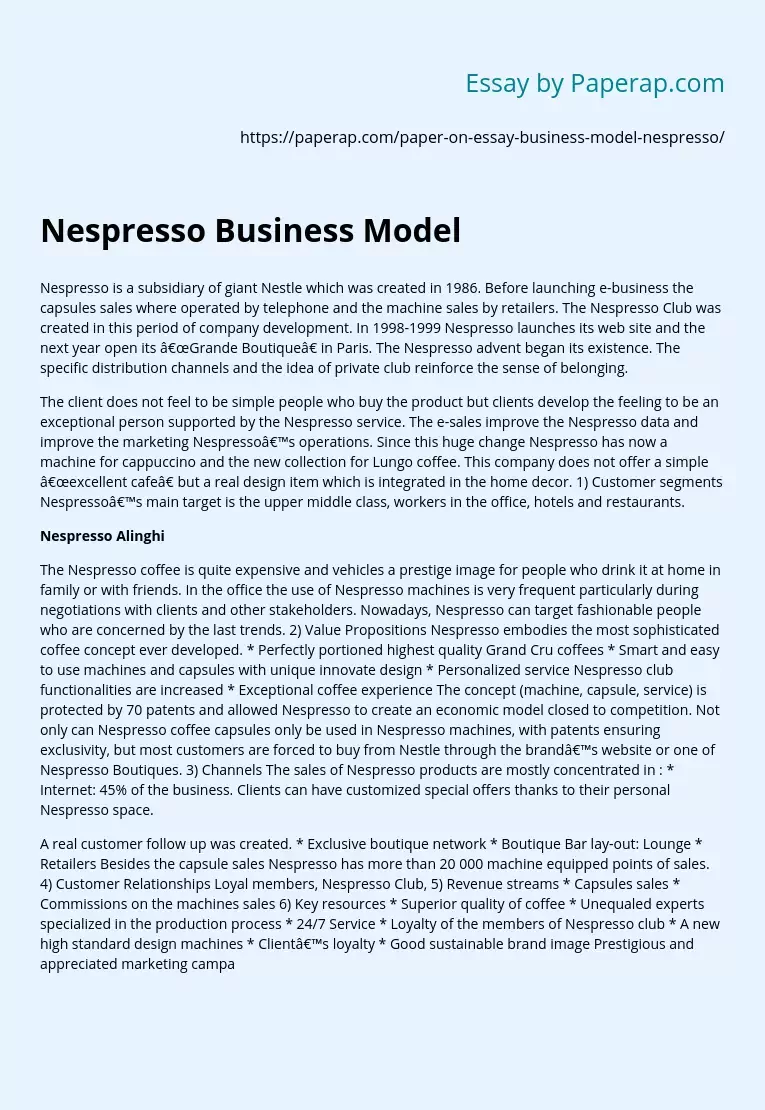Nespresso Alinghi Business Model
Nespresso is a subsidiary of giant Nestle which was created in 1986. Before launching e-business the capsules sales where operated by telephone and the machine sales by retailers. The Nespresso Club was created in this period of company development. In 1998-1999 Nespresso launches its web site and the next year open its “Grande Boutique” in Paris. The Nespresso advent began its existence. The specific distribution channels and the idea of private club reinforce the sense of belonging.
The client does not feel to be simple people who buy the product but clients develop the feeling to be an exceptional person supported by the Nespresso service.
The e-sales improve the Nespresso data and improve the marketing Nespresso’s operations. Since this huge change Nespresso has now a machine for cappuccino and the new collection for Lungo coffee. This company does not offer a simple “excellent cafe” but a real design item which is integrated in the home decor. 1) Customer segments Nespresso’s main target is the upper middle class, workers in the office, hotels and restaurants.
The Nespresso coffee is quite expensive and vehicles a prestige image for people who drink it at home in family or with friends. In the office the use of Nespresso machines is very frequent particularly during negotiations with clients and other stakeholders. Nowadays, Nespresso can target fashionable people who are concerned by the last trends. 2) Value Propositions Nespresso embodies the most sophisticated coffee concept ever developed. * Perfectly portioned highest quality Grand Cru coffees * Smart and easy to use machines and capsules with unique innovate design * Personalized service Nespresso club functionalities are increased * Exceptional coffee experience The concept (machine, capsule, service) is protected by 70 patents and allowed Nespresso to create an economic model closed to competition.
Not only can Nespresso coffee capsules only be used in Nespresso machines, with patents ensuring exclusivity, but most customers are forced to buy from Nestle through the brand’s website or one of Nespresso Boutiques. 3) Channels The sales of Nespresso products are mostly concentrated in : * Internet: 45% of the business. Clients can have customized special offers thanks to their personal Nespresso space.
A real customer follow up was created. * Exclusive boutique network * Boutique Bar lay-out: Lounge * Retailers Besides the capsule sales Nespresso has more than 20 000 machine equipped points of sales. 4) Customer Relationships Loyal members, Nespresso Club, 5) Revenue streams * Capsules sales * Commissions on the machines sales 6) Key resources * Superior quality of coffee * Unequaled experts specialized in the production process * 24/7 Service * Loyalty of the members of Nespresso club * A new high standard design machines * Client’s loyalty * Good sustainable brand image Prestigious and appreciated marketing campaign (Sponsoring Alinghi and America’s Cup, Georges Clooney) Nestle is working on ways to prevent competitors from taking advantage of the coming expiry of its patents. 7) Key activities * Constantly improve the chain value * Conserve the privileged relationships with clients * To conserve the capitalization of their good image and their stylish, unique and eco-friendly culture * Follow the construction of the Internet site 8) Key partnership Nespresso is one of the biggest sponsors of Alinghi and America’s Cup.
Partners with Nestle to utilize synergies in terms of: * Financial support * R&D * Specialist support in terms of tax, legal, public affairs etc * Purchasing power * Start-up in new markets Almost 8 machine partners: Magimix, Krups, Miele, Koenig, Alessi… There is a unique partnership with numerous hotels and restaurants which will sell the product to their customers. 9) Cost structure * The cost of the 24/7 service * Capsule production * Cost of sending parcels * Marketing cost which allowed the company to build the Brand reputation and spread its activity on new markets.
Nespresso Alinghi Business Model. (2019, Dec 05). Retrieved from https://paperap.com/paper-on-essay-business-model-nespresso/

